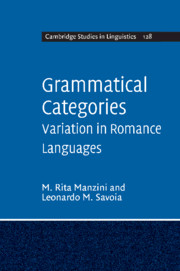Book contents
- Frontmatter
- Contents
- List of tables
- Acknowledgements
- Introduction: grammatical categories and the biolinguistic perspective
- 1 The structure and interpretation of (Romance) complementizers
- 2 Variation in Romance k-complementizer systems
- 3 Sentential negation: adverbs
- 4 Sentential negation: clitics
- 5 The middle-passive voice: evidence from Albanian
- 6 The auxiliary: have/be alternations in the perfect
- 7 The noun (phrase): agreement, case and definiteness in an Albanian variety
- 8 (Definite) denotation and case in Romance: history and variation
- Notes
- References
- Index
2 - Variation in Romance k-complementizer systems
Published online by Cambridge University Press: 11 April 2011
- Frontmatter
- Contents
- List of tables
- Acknowledgements
- Introduction: grammatical categories and the biolinguistic perspective
- 1 The structure and interpretation of (Romance) complementizers
- 2 Variation in Romance k-complementizer systems
- 3 Sentential negation: adverbs
- 4 Sentential negation: clitics
- 5 The middle-passive voice: evidence from Albanian
- 6 The auxiliary: have/be alternations in the perfect
- 7 The noun (phrase): agreement, case and definiteness in an Albanian variety
- 8 (Definite) denotation and case in Romance: history and variation
- Notes
- References
- Index
Summary
As observed in chapter 1, finite complementizers in Germanic and Romance are clearly nominal, belonging to argumental series such as demonstratives and wh–elements respectively. Therefore we propose that the complementizer is not a functional category of the verb, but rather an independent nominal head, which satisfies an argument slot of the matrix verb and which takes the embedded sentence as its complement. The aim of the present chapter is to investigate the range of variation in the lexicalization of complementizers in Romance varieties. We argue that only the treatment of the complementizer sketched in chapter 1 allows for a transparent account of the observed variation. First, the overlapping of Romance complementizers with the wh–system follows precise patterns, which excludes the possibility that we are merely dealing with homophony. Second, an account of the variation internal to the complementizer system requires the complementizer to be interpreted as introducing a propositional variable – which is natural if it is a nominal head, but not if it is a functional projection of the verb. In section 2.3, we also consider the finiteness restriction that complementizers are subject to, arguing that they do not select for embedded temporal/modal properties (this being a potential argument in favour of their status as a functional projection of the verb), rather they select for the properties of the embedded EPP argument – hence of the proposition as a whole.
Information
- Type
- Chapter
- Information
- Grammatical CategoriesVariation in Romance Languages, pp. 49 - 79Publisher: Cambridge University PressPrint publication year: 2011
